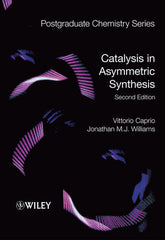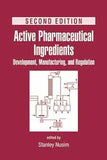Catalysis in Asymmetric Synthesis, 2nd Edition By Vittorio Caprio, Jonathan Williams(PAPERBACK Ed.)
Catalysis in Asymmetric Synthesis, 2nd Edition
Written from a synthetic organic chemistry perspective, this text provides a practical overview of the field, illustrating a wide range of transformations that can be achieved. The book captures the latest advances in asymmetric catalysis with emphasis placed on non-enzymatic methods.
Topics covered include:
- Reduction of alkenes, ketones and imines
- Nucleophilic addition to carbonyl compounds
- Catalytic carbon-carbon bond forming reactions
- Catalytic reactions involving metal carbenoids
- Conjugate addition reactions
Catalysis in Asymmetric Synthesis bridges the gap between undergraduate and advanced level textbooks and provides a convenient point of entry to the primary literature for the experienced synthetic organic chemist.
Preface to the First Edition.
1 Introduction.
1.1 Reactions Amenable to Asymmetric Catalysis.
1.2 Assignment of (R) and (S) Stereochemical Descriptors.
Futher Reading.
References.
2 Reduction of Alkenes.
2.1 Asymmetric Hydrogenation with Rhodium Complexes.
2.2 Asymmetric Hydrogenation with Ruthenium Catalysts.
2.3 Alkene Hydrogenation with Titanium and Zirconium Catalysts.
2.4 Alkene Hydrogenation with Iridium Catalysts.
2.5 Alkene Hydrogenation with Organocatalysts.
2.6 Alkene Hydrosilylation.
2.7 Alkene Hydroboration.
2.8 Hydroamination.
2.9 Hydroformylation.
2.10 Hydroacylation of Alkenes.
2.11 Hydrocyanation of Alkenes.
References.
3 Reduction of Ketones and Imines.
3.1 Hydrogenation of Ketones.
3.2 Hydrogenation and Transfer Hydrogenation of Imines and Related Compounds.
3.3 Transfer Hydrogenation of Ketones.
3.4 Heterogeneous Hydrogenation.
3.5 Reduction of Ketones Using Enantioselective Borohydride Reagents.
3.6 Hydrosilylation of Ketones.
3.7 Hydrosilylation of Imines and Nitrones.
References.
4 Epoxidation.
4.1 Epoxidation of Allylic Alcohols.
4.2 Epoxidation with Metal(salen) Complexes.
4.3 Epoxidation Using Metal–Porphyrin-Based Catalysts.
4.4 OtherMetal-Catalysed Epoxidations of Unfunctionalised Olefins.
4.5 Epoxidation of Electron-Deficient Alkenes.
4.6 Epoxidation with Iminium Salts.
4.7 Epoxidation with Ketone Catalysts.
4.8 Epoxidation of Aldehydes.
4.9 Aziridination of Alkenes.
4.10 Aziridination of Imines.
References.
5 Further Oxidation Reactions.
5.1 Dihydroxylation.
5.2 Aminohydroxylation.
5.3 α-Heterofunctionalisation of Aldehydes and Ketones.
5.4 Oxidation of C–H.
5.5 Baeyer–Villiger Oxidation.
5.6 Oxidation of Sulfides.
References.
6 Nucleophilic Addition to Carbonyl Compounds.
6.1 Addition of Organozincs to Carbonyl Compounds.
6.2 Addition of Cyanide to Aldehydes and Ketones.
6.3 Allylation of Aldehydes.
6.4 Hydrophosphonylation of Aldehydes.
6.5 Nucleophilic Additions to Imines.
References.
7 The Aldol and Related Reactions.
7.1 The Aldol Reaction.
7.2 Isocyanide and Related Aldol Reactions.
7.3 The Nitroaldol Reaction.
7.4 Addition of Enolates to Imines.
7.5 Darzens Condensation.
7.6 Morita–Baylis–Hillman Reaction.
7.7 Carbonyl-Ene Reactions.
References.
8 Cycloadditions.
8.1 Diels–Alder Reactions.
8.2 Inverse Electron Demand Diels–Alder Reactions.
8.3 Hetero-Diels–Alder Reactions.
8.4 1,3-Dipolar Cycloaddition Reactions.
8.5 [2+2] Cycloadditions.
8.6 Pauson–Khand-Type Reactions.
References.
9 Catalytic Reactions Involving Carbenes and Ylides.
9.1 Cyclopropanation.
9.2 Insertion Reactions.
9.3 Asymmetric Ylide Reactions.
References.
10 Catalytic Carbon–Carbon Bond-Forming Reactions.
10.1 Cross-Coupling Reactions.
10.2 Metal-Catalysed Allylic Substitution.
10.3 Heck Reactions.
10.4 Alkylmetalation of Alkenes.
References.
11 Conjugate Addition Reactions.
11.1 Conjugate Addition of Enolates.
11.2 Conjugate Addition of Sulfur Nucleophiles.
11.3 Conjugate Addition of Nonstabilised Nucleophiles.
11.4 Conjugate Addition with Nitrogen-Based Nucleophiles and Electrophiles.
References.
12 Further Catalytic Reactions.
12.1 Isomerisations and Rearrangements.
12.2 Deprotonation Reactions.
12.3 Protonation Reactions.
12.4 Alkylation and Allylation of Enolates.
12.5 Formation of Alkenes.
12.6 Oxyselenylation-Elimination Reactions.
12.7 The Benzoin Condensation.
12.8 Ester Formation and Hydrolysis.
12.9 Ring-Opening of Epoxides.
References.
Index.


















